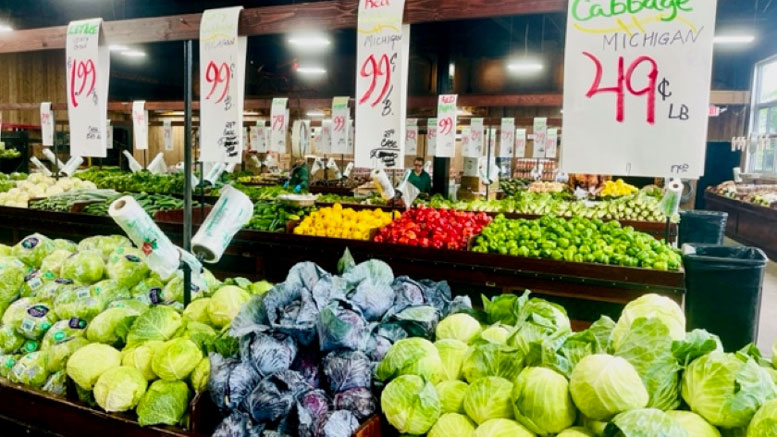Michigan Offers Powerhouse Supply of Fresh Produce
June 25, 2024 | 7 min to read
Michigan, the second most agriculturally diverse state in the U.S., thrives on fresh produce, with family-owned farms contributing over $104.7 billion to the economy. Retailers benefit from seasonal offerings like asparagus and sweet corn, thanks to the state's rich soils and ideal climate. With innovations like local farmer photos in stores and unique packaging, Michigan produce, especially blueberries and apples, resonates with consumers seeking freshness and local flavor.

Michigan ranks the second most agriculturally diverse state in the nation.
Originally printed in the June 2024 issue of Produce Business.
Dave Hansen has one rule for selling more fresh produce at Hansen Foods, a two-store chain he owns with locations in Hart and Suttons Bay, MI.
“We want our customers to say, ‘that looks good,’ because then they’ll buy. What’s important about Michigan-grown produce for us is that it’s fresh. For example, asparagus, sweet corn, tomatoes, and cucumbers are picked that morning and in-store that afternoon.”
Hansen also uses photos of local farmers on the wall in the produce department. “These same farmers shop at our stores, so when they say, ‘this looks good,’ we know we’ve done a good job,” he says.
WHY BUY FROM MICHIGAN
Retailers in the Midwest, East, and Southeastern U.S. can find a powerhouse supply of fresh produce from Michigan, especially in season.
“Many may not realize that Michigan ranks as the second most agriculturally diverse state in the nation, trailing only California,” says Michael Ceja, the Lansing, MI-based outreach specialist for the Michigan Ag Council, an organization of commodity groups and agribusinesses.
In 2022, Michigan’s 44,000-plus farms, which 98% are family-owned and operated, contributed over $104.7 billion to the state’s economy, producing more than 300 varieties of fresh foods and products. The state ranks first in the nation in 15 different products, including asparagus, Ceja adds.

The provision of Michigan-grown produce is important to Detroit, MI-based wholesaler Joe Randazzo’s Fruit & Vegetable Inc., which also operates four retail markets.
“We receive fresh produce daily,” says Sarah Randazzo DeLapp, marketing director, adding the company just built another dock and cooler to expand its delivery department.
NATURE’S ABUNDANCE
Natural attributes such as a temperate climate, rich soils, abundant water, and diverse growing regions, the latter of which spans nearly 400 miles from the Canadian border south to the Indiana and Ohio state lines, make Michigan a natural for agriculture.
The bulk of Michigan’s produce is grown on the west side of the state, primarily because of the climate and natural irrigation due to the proximity of growing regions to Lake Michigan.
“The soil is fertile, and the summer days are hot, and nights are cool, making for the flavors we all love,” says Trish Taylor, marketing manager for Riveridge Produce Marketing Inc., in Sparta, MI, which sells asparagus, apples, sweet cherries and prune plums.

“There is a bit of a produce trail up the west side of Michigan. Certain areas are known for growing bountiful produce — from the salad bowl area known for growing celery, tomatoes, and onions to the Ridge for apples to Leelanau for its tart cherries.”
Unlike its neighboring states, the Great Lakes-moderated climate buffers against excessive heat and cold, extending the state’s growing season into the fall.
“For example, our Michigan tomatoes will end two weeks later than the rest of the Midwest,” says Nick Teriaca, director of sales and procurement for BelleHarvest Sales Inc., in Belding, MI.
Michigan’s location near the middle of the U.S. is another advantage.
“Being centrally located can benefit us, especially if we’re able to grow much of the produce here that was historically known to come from the west,” says Riveridge’s Taylor.
PRODUCE CORNUCOPIA
Michigan produces a tremendous amount of fresh agricultural diversity.
“When the Michigan season is in full production, we source various products depending on the season. Some of the earlier items offered in Michigan are asparagus to start, then followed by cabbage, greens, and then will continue to expand the offerings until apple harvest,” says Jordan Grainger, vice president of sales and business development for wholesaler Ben B. Schwartz & Sons, Inc., in the Detroit Produce Terminal, Detroit, MI.
The company launched a new bagging operation for citrus this spring and plans to expand its bagged product offerings in the coming months.
Michigan is renowned for its asparagus, and Oceana County is celebrated as the asparagus capital of the world, according to Michigan Ag Council’s Ceja.
“Oceana is to asparagus what Napa is to grapes,” says Hansen of Hansen Foods. “We sell 20,000 pounds in a season. New is our Oceana Prime cut asparagus. The spears are 5 inches long. They aren’t banded, but displayed loose in a specially designed marketing box. Shoppers buy more that way.”
Michigan’s asparagus harvest takes place in May and June. Over 100 farmers on approximately 10,000 acres pick, pack, and ship some 20 million pounds of this green veggie during its six-week season, according to the Michigan Asparagus Advisory Board (MAAB) in DeWitt, MI.
“Michigan asparagus has a distinct, rich flavor. Since it is local, it will last longer in the shoppers’ refrigerator, and since it is hand-harvested by snapping the spear at ground level, our spears don’t require significant trimming, all of which provides more value to consumers,” says Jamie Clover Adams, the MAAB executive director.
North Bay Produce is a grower that produces a significant volume of asparagus each season, according to Brian Klumpp, director of sales and marketing for the Traverse City, MI, company.
“Organic produce is more of a challenge in the state due to the amount of precipitation, but we do offer organic asparagus.”
The company is also a major Michigan grower of apples and blueberries.
FRUITS FROM THE WOLVERINE STATE
Nearly a dozen and a half fruit categories are grown commercially in Michigan.
“The tree fruit industry has a more than $7 million economic impact on our state. We had record-breaking apple crops the past two seasons and expect another great season. Peaches will be ready in July through September, pears and plums from August to September, and apples harvest from August through October,” says Nancy Nyquist, executive director of the Michigan Tree Fruit Commission in Lansing, MI.
APPLES: Michigan ranks second in the nation for apple production, behind Washington State. About half the crop goes to processing, with the rest to the fresh market.
The apple harvest in Michigan begins in mid to late August through October, with storage fruit lasting into the spring.
“We announce our official estimate on Aug. 16, at the USApple Outlook Conference, but we are hearing from growers that this year’s bloom was one of the most beautiful in recent years,” says Diane Smith, executive director of the Michigan Apple Committee (MAC) in Lansing, MI. “It’s looking like we’ll have another large crop for 2024.”
Honeycrisp is a best-seller, says BelleHarvest’s Teriaca.
Michigan is a good state for growing newer varieties, adds Teriaca. “We grow SweeTango, Smitten and have planted Evercrisp. We plan to have these three newer varieties available this season, with much new growth in upcoming seasons.”
There is a high demand for early season premium flavored varieties, such as SweeTango and Rave, adds Brian Coates, vice president of Applewood Fresh Growers, LLC, in Sparta, MI.
“We plan to kick off our 2024 season with the best back-to-school apple, Rave, with plans to begin shipping in late August or early September,” Coates says, adding the first SweeTango will be shipped in early September.
Riveridge Produce Marketing has the largest commercial trial of organic apples in Michigan, says Taylor.
BLUEBERRIES: Michigan is a top producer of blueberries, with about 15,000 acres in the southwest part of the state, according to Nyquist, who is also the executive director of the Michigan Blueberry Commission in Grand Junction, MI.
North Bay Produce has made varietal development a focus for its business, including Michigan-grown Sekoya blueberries, according to Klumpp.

“We are pleased to offer our state labels this year for blueberries, and consumers and retailers have very well received this. With consumers’ continually growing interest in buying locally, these labels, which are in the shape of the states themselves, make it immediately clear to consumers that they are choosing Michigan blueberries when they buy our product.”
For decades, Midwest retailers have taken advantage of locally grown blueberries in Michigan to drive and enhance year-over-year blueberry sales, adds Brad Moorer, president and chief executive officer of MBG Marketing, a grower-owned blueberry and blackberry marketing cooperative in Grand Junction, MI.
“Retailers have consistently seen same-store sales on blueberries increase when they can promote locally grown.”

